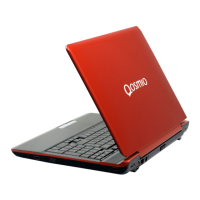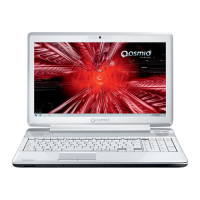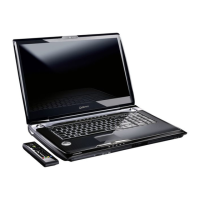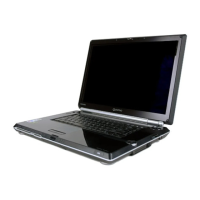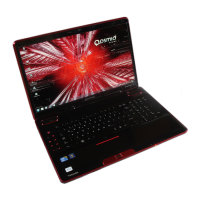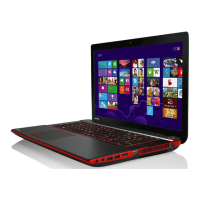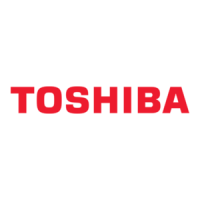
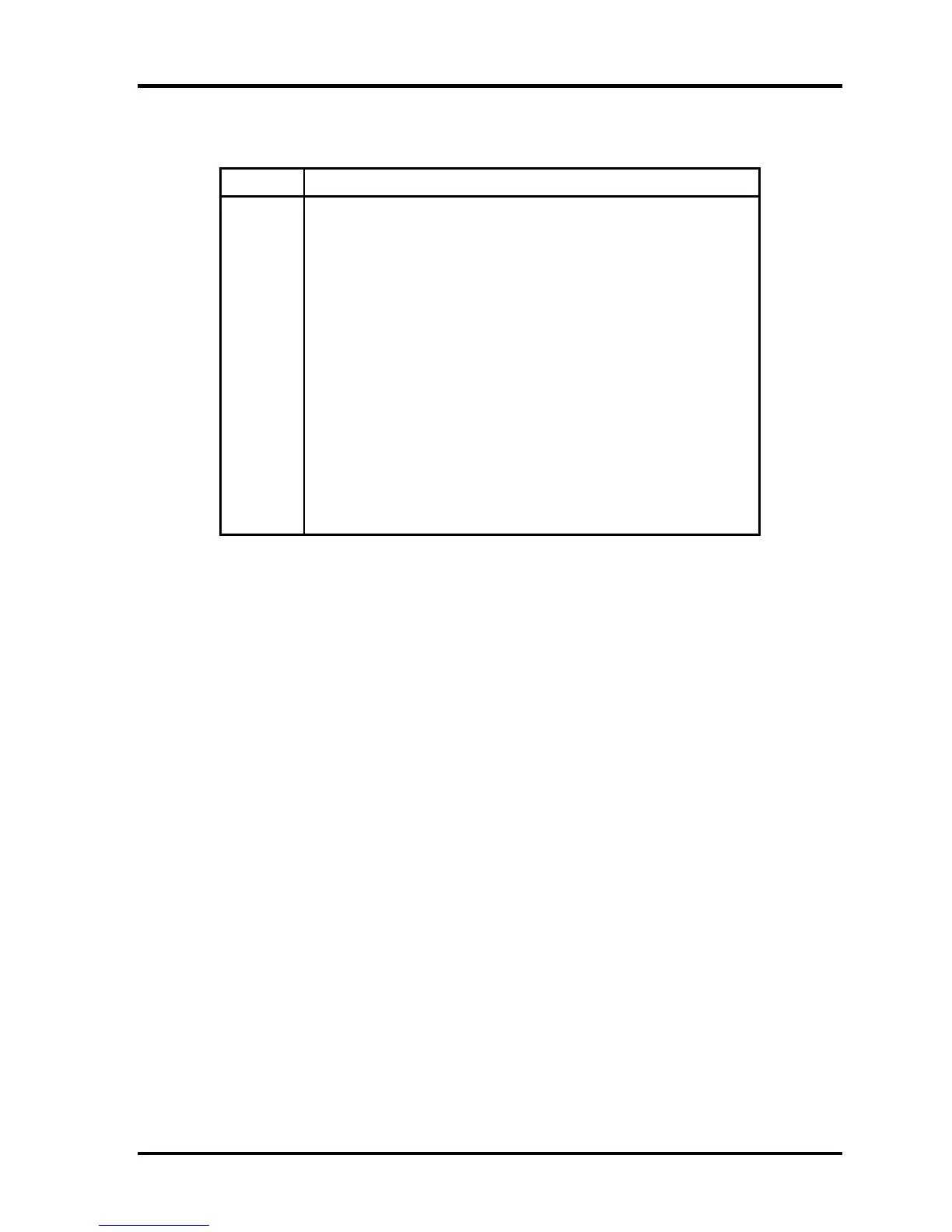
Do you have a question about the Toshiba QOSMIO F20 and is the answer not in the manual?
| Operating System | Windows XP Media Center Edition |
|---|---|
| RAM | 512 MB (expandable to 2 GB) |
| Storage | 80 GB HDD |
| Display | 15.4 inches |
| Optical Drive | DVD SuperMulti |
| Wireless | 802.11b/g |
| Ports | VGA |
| Battery | Lithium ion |
Toshiba QOSMIO F20 Maintenance Manual
Contains copyright information and a disclaimer regarding the manual's accuracy.
Outlines safety warnings (DANGER, WARNING, CAUTION, NOTE) for maintenance procedures.
Describes the division of the manual into chapters and appendices.
Explains conventions used in the manual for terms, keys, user input, and display.
Lists the key features and specifications of the QOSMIO F20 series PCs.
Illustrates the interconnection of various system components and their functions.
Details the dimensions and specifications of the 2.5-inch internal hard drives.
Describes the types of optical drives (DVD-ROM, CD-R/RW, DVD Super Multi) and their specifications.
Details the keyboard specifications, including key count and layout.
Provides specifications for the TFT color display, including LCD module and FL inverter.
Lists the power supply output ratings and the functions of the power supply microcontroller.
Details the main battery and RTC battery specifications and charging control.
Lists the specifications for the AC adapter used for charging the battery.
Introduces the chapter on identifying Field Replaceable Units (FRUs) causing malfunctions.
Guides users through a flowchart to determine troubleshooting procedures.
Provides procedures to troubleshoot power supply issues, including status checks and error codes.
Describes procedures to determine if the system board is defective, including message and debug port checks.
Details troubleshooting steps for the USB Floppy Disk Drive, including head cleaning.
Outlines procedures for troubleshooting the 2.5-inch Hard Disk Drive, including partition and format checks.
Provides steps to troubleshoot keyboard issues, including diagnostic tests and connector checks.
Details troubleshooting steps for the touch pad, including diagnostic tests and connector checks.
Covers troubleshooting for display issues, including external monitor and diagnostic tests.
Outlines troubleshooting steps for the optical drive, including diagnostic tests and connector checks.
Provides troubleshooting procedures for the modem, including diagnostic tests and connector checks.
Details troubleshooting steps for the LAN connection, including diagnostic tests and connector checks.
Outlines troubleshooting for wireless LAN issues, including transmitting-receiving and antenna connection checks.
Provides procedures to troubleshoot sound issues, including diagnostic tests and connector checks.
Details troubleshooting steps for the TV tuner, including connector and replacement checks.
Explains how to use diagnostic test programs to check hardware module functions.
Guides users on how to start and navigate the diagnostic programs.
Explains how to set hardware configuration and input DMI information.
Describes the automatic test program that executes subtests successively.
Lists subtest names for each program in the diagnostic test menu.
Details the system test, including ROM checksum and fan ON/OFF tests.
Explains memory tests like conventional memory and protected mode tests.
Describes the keyboard test, focusing on pressed key display and scan codes.
Details display tests such as VRAM read/write and gradation tests.
Explains tests for the floppy disk drive, including sequential read and write operations.
Outlines hard disk tests, including sequential read and address uniqueness tests.
Explains real-time tests, including setting date/time and backup memory checks.
Describes the NDP test, checking functions like control word and addition.
Details expansion tests, including PCMCIA wrap around and RGB monitor ID.
Explains CD-ROM/DVD-ROM tests, including sequential read and specified address tests.
Lists error codes and status names for diagnostic tests across various devices.
Provides detailed status information for hard disk test errors, including HDC status registers.
Describes tests for unique functions like keyboard, touch pad, and USB ports.
Details the function and operations for cleaning floppy disk drive heads.
Explains how to log error information and store results in RAM or on disk.
Describes the automatic execution of multiple tests in sequence.
Covers utilities for formatting, copying, and dumping floppy disks.
Displays current system setup information, including memory, BIOS, and drives.
Explains how to perform wireless LAN transmitting-receiving tests for Intel 802.11b/g cards.
Details wireless LAN transmitting-receiving tests for Intel 802.11a/b/g cards.
Describes wireless LAN tests for Atheros b/g and a/b/g cards.
Explains how to perform tests for LAN, Modem, Bluetooth, and IEEE1394 interfaces.
Details sound tests, including standard, legacy, and CD sound tests.
Explains how to access and navigate the system setup utility.
Introduces the chapter on FRU removal and replacement procedures with safety precautions.
Details the procedures for removing and installing battery packs, PC cards, and bridge media.
Provides procedures for removing and installing the Hard Disk Drive (HDD).
Details the procedure for removing and installing memory modules.
Explains the procedure for removing and installing the MDC (Modem Daughter Card).
Provides steps for removing and installing the keyboard assembly.
Details the procedure for removing and installing the switch membrane.
Covers the procedure for removing and installing the display assembly.
Explains the procedure for removing and installing the wireless LAN card.
Details the procedure for removing and installing the RTC battery.
Provides procedures for removing and installing the UA board.
Details the procedure for removing and installing the optical drive.
Explains the procedure for removing and installing the system fan.
Provides detailed procedures for removing and installing the system board.
Details the procedure for removing and installing the TV tuner module.
Explains the procedure for removing and installing the GPU heat sink and VG board.
Details the procedure for removing and installing the CPU heat sink and CPU.
Provides procedures for removing and installing the USB board and speakers.
Details the procedure for removing and installing the touch pad and volume knob.
Explains the procedure for removing and installing the LCD unit and FL inverter.
Details the procedure for removing and installing the wireless LAN antennas.
Provides procedures for removing and installing the display cover hinges.
Details the procedure for removing and installing the battery lock and latch.
Describes the replacement of fluorescent lamps for the LCD module.
Provides precautions for handling the LCD module to prevent damage.
Shows the layout of ICs and connectors on the system, UA, and VG boards.
Lists pin assignments for various connectors on the system board and other boards.
Provides scan codes and character mappings for keyboard keys.
Displays the keyboard layouts for US and UK configurations.
Contains wiring diagrams, specifically for the LAN loopback connector.
Explains how to rewrite the system BIOS program.
Details how to rewrite the EC/KBC system program.
Shows MTBF (Mean Time Between Failures) data for the system.
